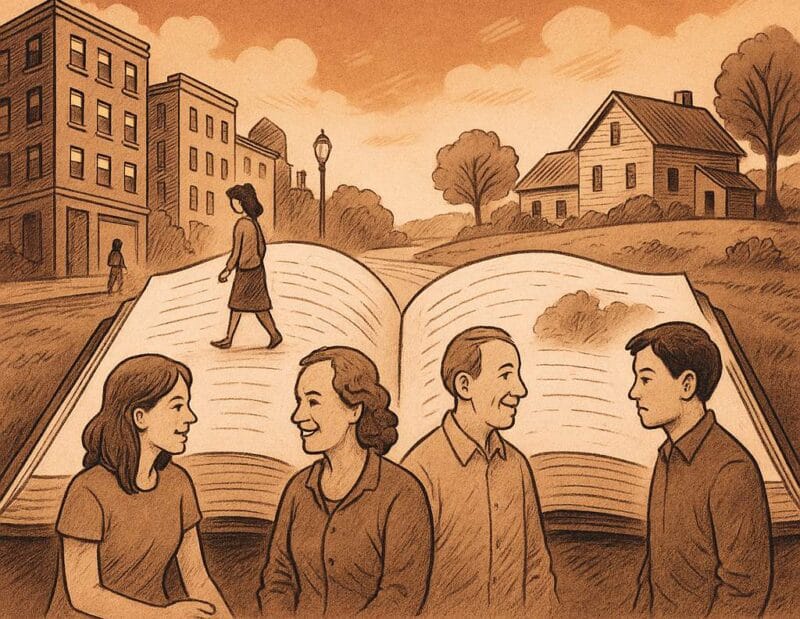A dog ear is a folded down corner of a book page. Dog-earing is commonly used to mark a section or phrase in a book that one finds to be important or of personal meaning. Other names for this practice include page folding and corner turning.
Dog-earing is a method of marking a page of a book by folding down one of its corners. You’ve probably seen it or even done it yourself—dog-earing a book to mark where you’ve left off. The term “dog-eared” is believed to have originated from the similar appearance between the folded page and a dog’s floppy ear.
This seemingly innocuous gesture has ignited fervent discussions among book lovers for ages. Though it appears uncomplicated, it holds deep significance for its practitioners. For some, it’s seen as a blasphemous act, while others consider it a badge of honor. While others judge it an unforgivable offense, some believe it’s a testament to a well-loved volume.

Is dog-earing a book a mark of love or disrespect?
In some societies, where books were historically rare and treasured, damaging a book in any form might be seen as disrespectful. In some literary circles, it’s seen as a cardinal sin—an act of defacement that borders on sacrilege. These purists argue that books should be treated with the utmost reverence as sacred objects deserving of pristine preservation. To them, dog-earing is a mark of disrespect, akin to scrawling graffiti on a priceless painting.
To a bibliophile or bookworm, a dog-eared page signifies neglect or disregard for the book’s physical integrity. They believe that books should be treated with the utmost care, preserved in their original condition for future generations to enjoy—they rather opt for bookmarks or other creative ways of marking their place. For them, books are not just a collection of pages; they are friends, mentors, and windows to other worlds. Therefore, the treatment of a book often reflects a reader’s reverence for the content within.

On the flip side, some view dog-earing as a form of active engagement with the text and a means to make a book of one’s own. For them, a dog-eared page indicates a passage that resonated, an emotion experienced, or a moment worth revisiting. According to this viewpoint, a book with dog-eared pages is a well-loved book that has been read and reread, its pages exhibiting the traces of a reader’s voyage.
A book full of dog-eared pages can be a diary of the reader’s journey through the text, each fold a testament to its impact on their life. This perspective values the connection between reader and book over the physical condition of the book itself. In a world filled with digital distractions, it’s a tactile and personal way of engaging with a physical book. It’s like a secret handshake among book lovers—a silent conversation between the reader and the author. Dog-earing is a practical solution to the age-old problem of losing bookmarks or forgetting where one left off.
Social Significance of Dog-Earing Amongst the Reading Public
At its heart, dog-earing is deeply personal. It’s a choice made by individual readers based on their relationship with books. For some, it’s a utilitarian method to track progress, while for others, it’s an emotional expression.
In social settings, like book clubs or literary gatherings, dog-eared books can stir conversations. They can be ice-breakers, leading to discussions about favorite passages, reading habits, or even debates on book etiquette.
Dog-earing a book carries social significance within the reading community. It’s a practice that has been passed down through generations of readers—a tradition that bridges the gap between book lovers of all ages. It’s a gesture that says, “I’ve been here; I’ve explored these words, and I want to come back.”
Moreover, in the digital age, where ebooks are becoming the norm, the act of dog-earing a physical book can be a nostalgic gesture, a reminder of the enduring appeal of physical books. Or it can be a rebellion against the transient nature of digital media, a longing for tactile interaction, and a tribute to the enduring charm of printed books—it’s a tangible act of resistance against the ephemeral nature of digital reading, a declaration that some stories are worth revisiting time and time again.
The practice of dog-earing a book is a small but significant gesture that conveys a great deal about the reader’s relationship with literature. It is a practice infused with tradition and personal significance. While the topic may be divisive, one thing is certain: dog-earing is evidence of the enduring relationship between readers and their books. Whether you consider it an act of devotion or a literary faux pas, the dog-eared page has cultural and social significance.

In addition to dog-earing pages, annotating a book is also a form of active engagement that involves interacting with the text by adding personal insights, highlights, and comments. Both practices—leaving marks and notes, whether scribbles in the margins or folded corners—serve as personal landmarks in your reading journey. They demonstrate a reader’s commitment to understanding and connecting with the material.
Whether you’re a purist who believes in preserving a book’s pristine condition or someone who considers creases and wear as a badge of honor, it’s important to recognize the various ways in which readers interact with their books. The controversy surrounding dog-earing serves as a reminder that books are not merely inanimate objects; they are vessels for human interaction, experience, and memory. And just as each reader’s approach to the pages they cherish is unique, so too is their approach to reading them.
Further Reading
11 Things Dog-Earing Readers Will Never Understand About Bookmark Users by Charlotte Ahlin, Bustle
In praise of dog-eared pages: the joy, memories and gentle ghosts to be found in beloved books by Jane Howard, The Guardian
Dog-earing books is considered a shameful habit these days — but it wasn’t always so by Kate Evans, The Bookshelf by ABC
Bookmarks versus dog ears: how you keep track of your reading – in pictures by Marta Bausells, The Guardian




